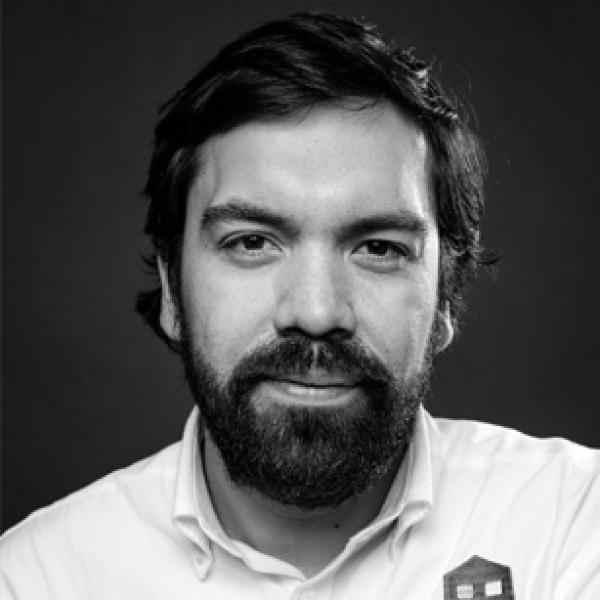Wprowadzenie
Noticing safety issues in his own neighborhood led Andrés Gallardo to create an app-driven network which allows neighbors to quickly respond to emergencies and communicate with each other about pertinent issues in their communities.
Nowy pomysł
Andrés is strengthening urban security in neighborhoods throughout Mexico and Latin America by creating a social network among neighbors and their family members, coworkers and friends. Different from the often inefficient and costly traditional security measures, Andrés' application - Haus - fulfills the demand for safer neighborhoods by offering a free mobile application to assist with health and safety emergencies. The system is offered in an application for smartphone users and an affordable watch for non-smartphone users. Haus has a geolocalized panic button for emergencies that connects the user with the neighbors in their network and with local authorities if desired.
The system also includes communication and organization features to enhance community resilience. The communities, bound together by a strong common interest - safety - organically develop relationships and regulate their own neighborhoods. This social cohesion acts to increase security in both preventive and defensive ways, as neighbors are more connected and willing to help each other.
Andrés is also contributing to the dialogue between civil society and local authorities. Though primarily a tool for citizens to communicate, congregate, and empower themselves in the interest of collective security, Haus also functions as a data communication tool between neighbors and regional governments. Haus offers crime statistics to the government which improves security efforts and policies on the local level.
Problem
A United Nations study places Latin America as the most criminally violent of all world regions. According to a 2015 government survey on Victimization and Perception on Public Security, more than 80 percent of Mexican citizens said they felt unsafe in their own neighborhood. Moreover, more than 75 percent say that they cannot rely on their neighbors if a problem arises. Crime is among the most urgent concerns facing Mexico and Latin America and low apprehension and conviction rates contribute to the high crime rate. This high level of perceived insecurity, along with a low level of social cohesion and mistrust of public authorities contributes to uncertainty and, in some cases, social unrest.
Public security measures in Mexico and Latin America have yet to provide an adequate solution to this widespread problem. Most public methods, such as alarms, are installed only in mid-high socioeconomic zones, continuing to leave lower-class areas vulnerable. The private security sector offers expensive solutions such as security cameras that most people in this region simply cannot afford. The existing security mechanisms tend to focus heavily on reactive measures while neglecting preventative measures. There are few systems that give communities the tools to work together and protect each other.
Strategia
Seeing the enormous lack of trust and sense of safety in urban Latin American communities, Andrés created an innovative, modern solution using digital peer-to-peer security. In 2015, Andrés launched Haus in Chile, but quickly established Haus headquarters in Mexico, due to the country's security challenges, the enormity of the market, and its strategic location between the United States and the rest of Latin America.
Haus' core product, the Haus App, is a powerful tool that establishes a shared security system for any community. Anyone can download it free of charge and as soon as more than five neighbors join the community, the group is "formalized" and given a security code, managed by the founder or the most active member of the group (called the "Key Neighbor"). Once added, users are instantly connected to a network of nearby residents even without their telephone contact. A principal feature is the panic button, which, when pressed, sends alerts to every neighbor in the community network and instantly publicizes the location of the person in need. Neighbors can then take a variety of measures, such as responding by chat, physically traveling to the emergency location, or simply turning on their lights to indicate that they are watching. The average neighborhood response to the panic button is less than one minute.
In addition to the security features, the Haus application is a communication channel that integrates the life of the community into its platform. Users can create news feeds using categories such as "Safety Concerns," "Maintenance Issues," or "Group Buying," which contribute to the social cohesion of each neighborhood. People in the La Soledad neighborhood of Bogota, Colombia used the Haus app to organize and raise money to put grass in a nearby park. This is an example of how the security of a neighborhood is not only about posting suspicious activity or crime alerts, but also about working together to build trust and improve the neighborhood.
For those who do not have access to a smartphone - roughly 30 percent of the user base - Haus offers the Haus bracelet, a SIM-card installed bracelet that comes with both the core security features (the panic button and GPS) as well as regular calling and messaging. This solution is especially designed for elderly citizens and children and is available with subsidy at a low monthly fee or free of charge if bought and distributed by local governments. If the user desires, the GPS and SMS messaging can be connected to the regional government or to a certain organization.
In addition to distributing the application and watches, Andrés works to establish relationships with each community. Andrés realizes that without the trust of users, the Haus app would not be as effective, as it would lose its community-based, grassroots appeal. The Haus team regularly visits neighborhoods to hold workshops on how to use the technology as well as to receive feedback and conduct consumer research. Users are given regular follow-up surveys via application after the meetings. Andrés makes a personal effort to attend those meetings and meet each neighborhood group, contributing to the relationship and helping Haus acquire more users within existing networks.
Haus does not charge a fee to its end-users. Instead, revenue comes from local governments and local businesses. Haus's macro database, the Haus Web, collects information on panic button usage as well as the distribution and size of each community, which allows a comprehensive and real-time view of the regional security landscape without sharing personal information or specific user data. Haus sells this data to municipal and federal governments in Mexico and Chile, who use it to improve safety policies and response. Protection of personal information is a defining principle of Haus's policy, for both ethical and practical reasons. Only in certain cases where the citizens specifically request connection to the government network can personal GPS data be incorporated into the government Haus Web system.
Haus is expanding the security features and will include other features that move beyond security, creating an application focused on community resilience, such as supporting victims of domestic violence. This feature will include a hidden button for female users, who can discretely contact organizations or officials that work with victims of domestic violence. This identity exposure is with the explicit consent of the user and will work with well-established relationships with appropriate NGOs or local officials.
Haus is also expanding the app to include group deals and coupons for local products and services. This will also enable Haus to provide the security platform for free to the end-user. This feature will be available exclusively for small business partners that share the local customer population and the team has already established local partnerships in many communities.
As an experienced application developer and entrepreneur, Andrés understands that a high-tech solution means nothing without real impact. In order to tackle the difficult task of measuring an increased sense of security within Haus communities, Haus uses its extensive backend technology to collect as many statistics as possible both on usage data, frequency of panic button use, response time to panic button use and regular in-app user survey results. Among this data, Andrés looks at two main indicators to measure impact: perception of insecurity and the daily usage per community.
To date, Haus has more than 7,000 neighborhood networks with more than 100,000 active users in Mexico and Latin America. Haus now has 13 full-time employees across six countries. The internal structure of Haus was designed to target international growth from the beginning, setting up virtual offices rather than physical offices where members communicate and share information. Haus intends to expand its services through partnerships and, within the next five years, aims to collaborate with 20 percent of the local governments in Mexico and Latin America and acquire 50 million users.
Osoba
Growing up in Santiago, Chile, Andrés was often home alone or with his grandparents, as his mother worked several jobs to support him. Though he did not feel unsafe, he knew from an early age that urban children and elderly populations were vulnerable. Andrés was creative and curious, and when he discovered the internet for the first time at age fifteen, he was fascinated by its ability to connect people. As an eclectic individual interested in music, technology and history, he decided to study philosophy. After graduating from university, he got a temporary job as a sales representative for a large bank and was quickly promoted. For the next 9 years, he worked for international finance corporations in Chile on different projects, such as researching financing options for low-income people in Latin America. He learned about needs-based approaches to services, as the services offered by his bank were not designed to meet the real financial and social realities of this population. Andrés was eventually put in charge of business intelligence and innovation and he worked on projects involving more than 400 million customers throughout Latin America.
Andrés soon realized that the financial corporate sector gave him great experience and important contacts, but it did not help him solve the problems that mattered to him. He also began to observe disconnection and safety issues around his neighborhood and that residents in dangerous areas felt safer if they were strongly connected to each other. After talking with his Latin American contacts, he determined that feeling unsafe was more widespread and a continental problem. People in emergencies would greatly benefit by immediate communication and support from their neighbors. Andrés knew then that this was the project where he could use his expertise to create a positive impact. In July 2014, he partnered with a Brazilian software engineer to develop the application. With his partner's technical knowledge and Andrés' business know-how, Haus formally launched in Chile in 2015.
An unexpectedly popular reception of the application - with 20,000 downloads since 2015 all over Latin America - led Andrés to reposition Haus' strategy within the first few months. He saw the potential for Haus to become a continental, if not global, application, and turned his attention to Mexico, a country where a staggering 80 percent of its citizens feel unsafe in their own neighborhood. With the help from a Startup Mexico grant, Andrés moved to Mexico City to establish company headquarters. He partnered with the government and began to meet and train people in neighborhoods throughout the country. Andrés believes that well-developed technology, accompanied by real human connections and government partnerships, is a solution to the security challenges in Mexico and Latin America.




